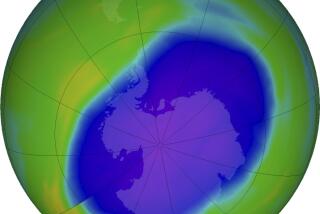Ozone Layer ‘Hole’ Appears Due to Chlorofluorocarbons, Study Finds
- Share via
New measurements of ozone concentrations over the Antarctic appear to confirm that release of chlorofluorocarbons into the atmosphere, rather than natural phenomena, is the cause of the sharp decrease of stratospheric ozone during the Southern Hemisphere’s spring. But the data does not fit well with any of the current theories about the precise mechanism of the depletion, scientists reported Thursday.
The finding suggests that scientists need to learn a lot more about what is going on in the Antarctic atmosphere in order “to clarify the cause of this remarkable phenomenon,” said Susan Solomon of the National Oceanographic and Atmospheric Administration.
Scientists had hoped that studies of the mysterious “hole” that appears in the Antarctic stratosphere each September and October would provide insight into the global depletion of stratospheric ozone, which many believe may be a result of the release of chlorofluorocarbons into the atmosphere.
Ozone levels in the hole, which is about five miles thick and is the size of the United States, are reduced by 35% to 50%, and the depletion seems to be increasing each year. Many scientists view the Antarctic hole, discovered in 1985, as a precursor of a more widespread, if less severe, loss of stratospheric ozone caused by chlorofluorocarbons.
Shields the Earth
Ozone in the stratosphere, which extends from about six to 30 miles above the Earth’s surface, shields the Earth from virtually all of the damaging ultraviolet light emitted by the sun. Scientists are confident that chlorofluorocarbons rise to the stratosphere and destroy ozone. Chloroflurocarbons are widely used as a refrigerant in air conditioners and refrigerators and for producing foam insulation.
At a U.N.-sponsored meeting in Geneva in December, the United States proposed an immediate freeze on world production of the chemicals, followed by a gradual phasing out of their use.
Last September and October, 18 scientists went to McMurdo Station in Antarctica as part of the U.S. National Ozone Expedition to study the hole. Thursday’s report, published in the prestigious British journal, Nature, by physicist David J. Hofmann and his colleagues from the University of Wyoming, is the first scientific report resulting from the expedition.
Balloons Used
Hofmann and his colleagues used balloons to measure actual ozone concentrations at various altitudes. Previous measurements had been made by satellites, which showed only the total amount of ozone in a column of air above the surface.
They found that all of the ozone loss was concentrated in a region between seven and 12 miles above the surface, with the greatest loss occurring about nine to 10 miles above the surface.
At some altitudes, ozone concentrations declined as low as 90% below normal. This surprised scientists because most theories predicted that the depletion would be spread throughout the stratosphere.
Some scientists had speculated that a warming of Antarctic air after the long winter night might cause it to rise rapidly, creating a “fountain” effect that would sweep ozone out of the stratosphere. Hofmann’s data, however, indicates that there is no significant vertical movement of air, thus eliminating the possibility.
Solar Activity
Measurement of the concentrations of certain other components of the stratosphere, Hofmann said in a telephone interview, showed that increased solar activity resulting from the sunspot cycle also could not have caused the depletion.
The only thing left, he said, is the activity of chlorofluorocarbons.
Hofmann’s measurements also showed that the ozone depletions are closely associated with the polar stratospheric cloud layer. Clouds are formed in the stratosphere only in the Arctic regions, and only in the winter, because those are the only times and places where the temperature is cold enough to condense the very small amount of water at that altitude.





